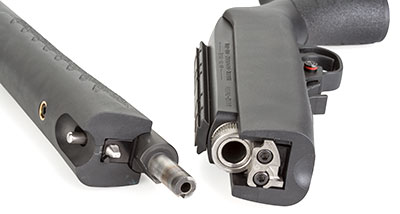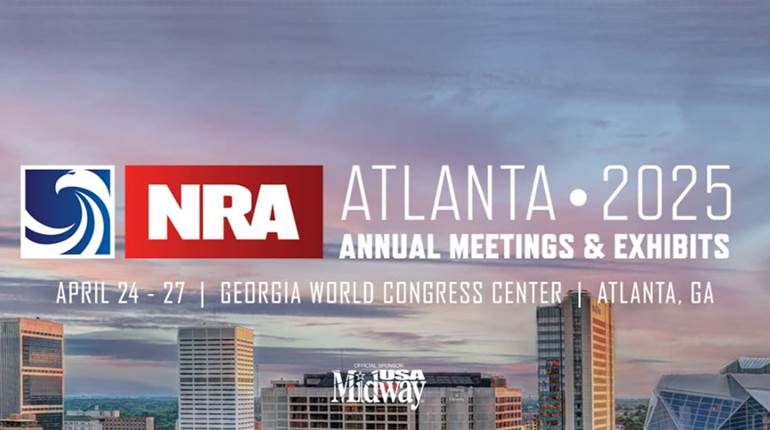
Ruger entered the suppressor market back in 2016 with the introduction of the Silent-SR, a conventional direct-thread rimfire model, and then followed that introduction up the subsequent year with the Silent-SR ISB, the subject of this review. Available only as an aftermarket accessory and subject to an NFA tax stamp, the ISB is an integrally suppressed replacement barrel designed for use with any of the company’s numerous takedown-capable rimfire models (the 10/22 Takedown and 10/22 Takedown Lite rifles and the 22 Charger Takedown pistol) that allows for instant, reversible conversion of the host platform into a suppressed firearm. For the purpose of this evaluation, we also acquired from Ruger a fluted, bull-barrel version (Model No. 21133) of the 10/22 Takedown—to both serve as a host for the ISB and to provide an unsuppressed baseline with which to compare the silencer’s effectiveness.

Measuring 16 1⁄8" long and weighing 42 ozs., the ISB consists of a 10" 416 stainless steel barrel and a 6" series of baffles enclosed within a 6061 aluminum housing that Ruger calls the sleeved barrel assembly. The suppressor’s six internal baffles, as well as the spacer and front cap that bookend them, are all made of 17-4 stainless steel, while the assembly screw that runs the length of the baffle stack and secures it in place within the sleeved barrel assembly is alloy steel.
The unit’s polymer fore-end bears the same ribs and molded-in texturing as the host gun’s standard barrel assembly, it has just been shortened slightly. Due to the positioning of the assembly screw—below and parallel to the barrel—a 10/22 Takedown with the ISB installed gives off the appearance of an over-under shotgun more than anything else. Ruger’s ISB shares the 1:16" right-handed twist rate used by all of the company’s .22 Long Rifle-chambered firearms.

The ISB utilizes the same method of attachment as do the barrel assemblies of the rest of Ruger’s rimfire Takedown models (as well as the PC Carbine). Once the action has been locked open, depressing a spring-tensioned lever located inside a recess in the rear bottom of the fore-end allows the unit to be rotated clockwise 45 degrees until it comes free of the receiver. Installation is in reverse. With a length identical to that of our host 10/22 Takedown’s factory front end, the ISB actually weighs 4 ozs. less than the stock barrel assembly. As a result, a 10/22 Takedown equipped with the ISB provides a suppressed package far more handy and compact than can be achieved with even the smallest of detachable silencers.
Rimfire suppressors require frequent maintenance, and Ruger has made disassembly of the ISB extremely simple for this purpose. Just loosen, but do not completely remove, the assembly screw with the included hex key, and then pull it from the sleeve; the entire baffle stack should come with it. The baffles can then be snapped apart and cleaned separately, as can the interior of the barrel sleeve. The company recommends a full cleaning after every few thousand rounds fired.
In testing the ISB, we evaluated it both as a barrel—comparing the accuracy and velocity of ammunition shot through the suppressor relative to that of ammunition fired through the stock unsuppressed barrel—in addition to quantifying its sound-suppression qualities as a silencer. During accuracy testing, we fired five, 10-shot groups through each barrel—using one subsonic (Winchester’s 45-gr. Super Suppressed) and one supersonic (Remington’s 36-gr. 22 Viper) load—at 50 yds.
Suppressors have the capacity to impact accuracy either positively, negatively or not at all, and our test sample appeared to have the latter effect. While the average group size of the subsonic Winchester load through the ISB (1.72") was somewhat larger than through the factory barrel (1.64"), and, conversely, the average of the supersonic Remington load was slightly smaller with the suppressor (1.78") than without (1.81"), in both cases the variations were minor enough to have potentially been incidental.
In terms of bullet velocity, the ISB’s influence was also limited. Despite only possessing 10" of rifled barrel, 10 rounds of the subsonic load fired through the suppressed unit averaged 1028 f.p.s.—only 15 f.p.s. slower than the average through the 16.12" unsuppressed barrel (1043 f.p.s.). Meanwhile, Remington’s supersonic load was a mere 21 f.p.s. slower through the ISB (1263 f.p.s.) than the factory barrel (1284 f.p.s.).
Per American Rifleman’s testing procedure for evaluating the effectiveness of a suppressor, we first used a sound meter to measure the average report (in dBs) of an unsuppressed five-shot group at both the shooter’s ear and the muzzle, then shot a second five-shot group through the suppressor at each location and compared the results. The ISB was given three minutes to cool down between each shot, and the unit was cleaned using an ultrasonic cleaner between loads.
At the shooter’s ear, the subsonic Super Suppressed load registered as 137.4 dBs when fired through the unsuppressed factory barrel, but 114.7 dBs when the ISB was employed—a reduction of 22.7 dBs. Results with the supersonic 22 Viper load were not as impressive, as the ammunition averaged an unsuppressed impulse of 136.1 dBs at the ear and a suppressed reading of 127.2 dBs, for a decibel reduction of 8.9 dBs. Both the ISB’s subsonic and supersonic at-the-ear figures were somewhat higher than we’ve encountered in previously tested rimfire suppressors. Much of this can be attributed to the simple fact that, when in use—by dint of it being an integrally suppressed barrel—the shooter’s head is 6" (or more) closer to the muzzle of the ISB than it is to the end cap of a separable suppressor affixed to the end of a threaded barrel.

Point-of-impact shift between the factory barrel and the ISB was considerable. At 50 yds., the subsonic Winchester load dropped approximately 10" down and 4" to the left, while the hot Remington ammunition shifted 8" down and 6" left—so plan for some re-zeroing when switching between the two. We were a little concerned about reliability when the very first shot of Winchester’s subsonic ammunition failed to cycle the rifle’s action, but the combination of 10/22 and ISB ran without further issue through approximately 500 rounds of testing. While we by no means torture-tested the ISB, several 25-shot magazine dumps were performed, and to our surprise, at no point did the suppressed barrel become more than slightly warm.
 To say that an ISB-equipped 10/22 Takedown provides a pleasant range experience would be a significant understatement; recoil is nil, blast is markedly reduced and the platform balances no worse when suppressed as when not. For those unfazed by the suppressor-buying process and already in possession of a take-down-capable Ruger rimfire model, the unit deserves serious consideration. Conventional suppressors offer enhanced functionality at the price of handiness; the Ruger Silent-SR ISB requires no such compromise.
To say that an ISB-equipped 10/22 Takedown provides a pleasant range experience would be a significant understatement; recoil is nil, blast is markedly reduced and the platform balances no worse when suppressed as when not. For those unfazed by the suppressor-buying process and already in possession of a take-down-capable Ruger rimfire model, the unit deserves serious consideration. Conventional suppressors offer enhanced functionality at the price of handiness; the Ruger Silent-SR ISB requires no such compromise.






































